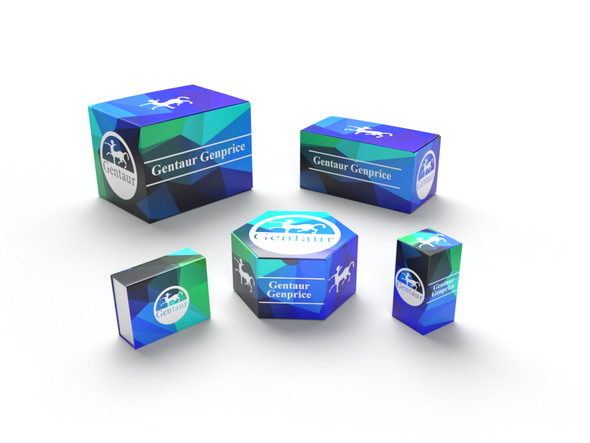Description
CHK1 Antibody [AMM02489G] | Gentaur UK, US & Europe Distribution
Product Category: Monoclonal Antibodies
Host: Mouse
Species Reactivity: H, M
Specificity: This monoclonal antibody is generated from mice immunized with Ni-NTA purified recombinant protein CHK1 expressed in E. Coli strain M15.
Cellular Localisation: Nucleus. Chromosome. Cytoplasm Cytoplasm, cytoskeleton, microtubule organizing center, centrosome. Note=Nuclear export is mediated at least in part by XPO1/CRM1 (PubMed:12676962) . Also localizes to the centrosome specifically during interphase, where it may protect centrosomal CDC2 kinase from inappropriate activation by cytoplasmic CDC25B (PubMed:15311285) . Proteolytic cleavage at the C-terminus by SPRTN promotes removal from chromatin (PubMed:31316063)
Molecular Weight: 54434
Clone: Monoclonal
Gene Name: CHEK1
Gene ID: 1111
Function: Serine/threonine-protein kinase which is required for checkpoint-mediated cell cycle arrest and activation of DNA repair in response to the presence of DNA damage or unreplicated DNA (PubMed:11535615, PubMed:12446774, PubMed:12399544, PubMed:14559997, PubMed:14988723, PubMed:15311285, PubMed:15665856, PubMed:15650047, PubMed:32357935) . May also negatively regulate cell cycle progression during unperturbed cell cycles (PubMed:11535615, PubMed:12446774, PubMed:12399544, PubMed:14559997, PubMed:14988723, PubMed:15311285, PubMed:15665856, PubMed:15650047) . This regulation is achieved by a number of mechanisms that together help to preserve the integrity of the genome (PubMed:11535615, PubMed:12446774, PubMed:12399544, PubMed:14559997, PubMed:14988723, PubMed:15311285, PubMed:15665856, PubMed:15650047) . Recognizes the substrate consensus sequence [R-X-X- S/T] (PubMed:11535615, PubMed:12446774, PubMed:12399544, PubMed:14559997, PubMed:14988723, PubMed:15311285, PubMed:15665856, PubMed:15650047) . Binds to and phosphorylates CDC25A, CDC25B and CDC25C (PubMed:9278511, PubMed:12676583, PubMed:14681206, PubMed:12676925, PubMed:12759351, PubMed:19734889, PubMed:14559997) . Phosphorylation of CDC25A at 'Ser-178' and 'Thr-507' and phosphorylation of CDC25C at 'Ser-216' creates binding sites for 14-3-3 proteins which inhibit CDC25A and CDC25C (PubMed:9278511) . Phosphorylation of CDC25A at 'Ser- 76', 'Ser-124', 'Ser-178', 'Ser-279' and 'Ser-293' promotes proteolysis of CDC25A (PubMed:9278511, PubMed:12676583, PubMed:14681206, PubMed:12676925, PubMed:12759351, PubMed:19734889) . Phosphorylation of CDC25A at 'Ser-76' primes the protein for subsequent phosphorylation at 'Ser-79', 'Ser-82' and 'Ser-88' by NEK11, which is required for polyubiquitination and degradation of CDCD25A (PubMed:9278511, PubMed:19734889, PubMed:20090422) . Inhibition of CDC25 leads to increased inhibitory tyrosine phosphorylation of CDK-cyclin complexes and blocks cell cycle progression (PubMed:9278511) . Also phosphorylates NEK6 (PubMed:18728393) . Binds to and phosphorylates RAD51 at 'Thr-309', which promotes the release of RAD51 from BRCA2 and enhances the association of RAD51 with chromatin, thereby promoting DNA repair by homologous recombination (PubMed:15665856) . Phosphorylates multiple sites within the C-terminus of TP53, which promotes activation of TP53 by acetylation and promotes cell cycle arrest and suppression of cellular proliferation (PubMed:10673501, PubMed:15659650, PubMed:16511572) . Also promotes repair of DNA cross-links through phosphorylation of FANCE (PubMed:17296736) . Binds to and phosphorylates TLK1 at 'Ser-743', which prevents the TLK1-dependent phosphorylation of the chromatin assembly factor ASF1A (PubMed:12660173, PubMed:12955071) . This may enhance chromatin assembly both in the presence or absence of DNA damage (PubMed:12660173, PubMed:12955071) . May also play a role in replication fork maintenance through regulation of PCNA (PubMed:18451105) . May regulate the transcription of genes that regulate cell-cycle progression through the phosphorylation of histones (By similarity) . Phosphorylates histone H3.1 (to form H3T11ph) , which leads to epigenetic inhibition of a subset of genes (By similarity) . May also phosphorylate RB1 to promote its interaction with the E2F family of transcription factors and subsequent cell cycle arrest (PubMed:17380128) . Phosphorylates SPRTN, promoting SPRTN recruitment to chromatin (PubMed:31316063) . Reduces replication stress and activates the G2/M checkpoint, by phosphorylating and inactivating PABIR1/FAM122A and promoting the serine/threonine-protein phosphatase 2A-mediated dephosphorylation and stabilization of WEE1 levels and activity (PubMed:33108758) .
Summary: Tissue Location: Expressed ubiquitously with the most abundant expression in thymus, testis, small intestine and colon
Form: Purified polyclonal antibody supplied in PBS with 0.09% (W/V) sodium azide. This antibody is purified through a protein G column, followed by dialysis against PBS.
Storage: Maintain refrigerated at 2-8°C for up to 2 weeks. For long term storage store at -20°C in small aliquots to prevent freeze-thaw cycles.
Application: WB
Dilution: WB--1:1000-1:2000 WB--1:1, 000~4, 000
Synonyms: Serine/threonine-protein kinase Chk1, CHK1 checkpoint homolog, Cell cycle checkpoint kinase, Checkpoint kinase-1, CHEK1, CHK1

![CHK1 Antibody [AMM02489G] CHK1 Antibody [AMM02489G]](https://cdn11.bigcommerce.com/s-1rdwiq712m/images/stencil/608x608/products/54664/463836/gentaur-genprice__26005.1661610467__29809.1661628092__75433.1661676199__77988.1661684280__64362.1661692443__02085.1662049603__45075.1662119302__91744.1662191540__21580.1662291419__56649.1663322644.png?c=1)




